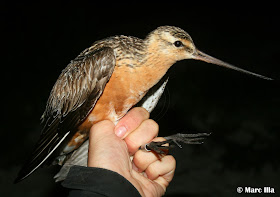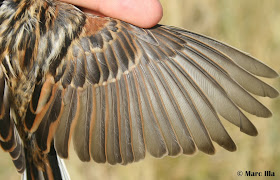In late July, many adult waders are already in migration, specially the orange coloured ones: Red Knot (Calidris canutus), Curlew Sandpiper (Calidris ferruginea) and Bar-tailed Godwit (Limosa lapponica). Also, good numbers of Dunlins (Calidris alpina) are around.









Also, this ferruginea can be sexed as a female. Males are richer coloured in underparts.




Nabben and the Mäklappen beach, to the south-west corner of the peninsula, are two of the best places for birding in the area. There were lots of waders a few days ago, with an specially nice flock of about 150 Knots. I tried to make a video using my phone and the scope, here you can see the result.
We went out at night to catch them, together with Timmy, Emil and Erik. And we actually managed to catch some!!
We got 19 adult Dunlins (Calidris alpina). As far as I know, second year birds are possible to determine because of the worn flight feathers, small and droplet-shaped white on the tip of the primary coverts, and for the presence of inner juvenile-type median coverts, with tawny edges. For further and much more detailed information about Dunlins, I fully reccomend the website www.dunlin.se.
 |
| Adult, 3+, (EURING 6). |
 |
| Second year (EURING 5). |
 |
| 3+ on the left, second year on the right. Note the differences in wear and colour edges of the upper tail coverts. |

7 Red Knots (Calidris canutus) were trapped as well, a very nice species in hand. As some first winter birds can do a complete moult, and if there's no retained feathers, adults should be aged as 2+ (EURING 4).



With Curlew Sandpipers (Calidris ferruginea), and in ageing terms, it happens something similar with Knots. Seemingly, some 1w can undergo a complete moult in Africa. Thus, the bird we trapped this year (on the top), with 3+ (EURING 6) appearence, should be aged as a 2+ (EURING 4), at least until more research is done. Nonetheless, the bird I trapped last year (on the bottom) can now be safely aged as a second-year (EURING 5).



Also, this ferruginea can be sexed as a female. Males are richer coloured in underparts.

Is was a great surprise when we found this Bar-tailed Godwit (Limosa lapponica) in the nets. It was actually smaller than expected, but nicer!

It was a 3+ (EURING 6), second-years have very worn primaries, and usually they don't attain full summer plumage (Prater et al. 1977). Also, tail feathers are adult patterned, and the bird is a male; specially for the bright underparts.


Why are all this waders orangish in summer? I've been looking for some explanation, but I haven't found anything. As the colour is a deep orange, I guess the phaeomelanin will be the main component of it. I don't think carotenoids would be very related to this colouration...
Also, the tone is more or less the same in very different species, like Knots, Curlew Sandpipers and Godwits. Who knows...


Why are all this waders orangish in summer? I've been looking for some explanation, but I haven't found anything. As the colour is a deep orange, I guess the phaeomelanin will be the main component of it. I don't think carotenoids would be very related to this colouration...
Also, the tone is more or less the same in very different species, like Knots, Curlew Sandpipers and Godwits. Who knows...





















































